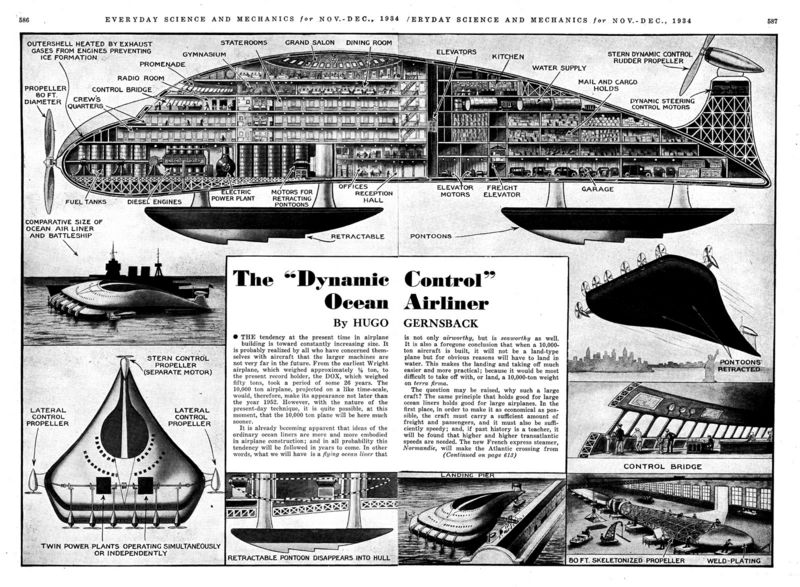File:Everyday Science and Mechanics, November 1934 - 005.jpg

Original file (1,600 × 1,173 pixels, file size: 548 KB, MIME type: image/jpeg)
Nobody can say Hugo was without a brilliant imagination -- he's also adept at using real-world statistics to prove his ideas. If the average weight of an airplane kept increasing at the same rate as the 1930s, a 10,000 ton (that's 20,000,000 - twenty million - pounds) plane would only be twenty years away. It's not completely insane -- the An-225, the heaviest plane so far[1] is around half that. Hugo's design takes a huge left turn off into the realm of science fiction. It combines the flying wing idea, basic airfoil concepts, mixes in a dash of ocean-liner grandeur, and then scales them up to an absurd scale.
The basic concepts seem reasonable: the body generates lift, sea-landing is the most reasonable place for such a large plane to land, and the greater cargo & passenger payload will increase economy. 80-foot diameter propellers are enormous (the Spruce Goose's propellors were 17' diameter[2] -- but an 80' diameter is more akin to a helicopter, and helicopter blades (even beyond Hugo's time) can produce enormous power. NASA is currently working on "blended body aircraft", a flying-wing airliner that has an enormous passenger hold, and looks surprisingly like Hugo's concept in profile [3]. What's Hugo missing?
Well, by 1930s technology, his ship would be far too heavy, ungainly, and impractical -- he assumed that, by the 1950s, we'd reach that point and something like this would be possible. By the time we developed the technology to make a plane of such size possible, however, speed and economy were the norm rather than the opulence of transcontinental travel. Paying for access to a grand ballroom or gymnasium on a day-long flight to London has no appeal for today's travelers. Those willing to pay for the 'first class' of an ocean liner were looking for the experience of the liner, and were willing to take the time to cross the ocean. The means to a destination shrunk to nothing, and simply getting there the cheapest way available became the target. If not for that change, we would see aircraft that rival the ocean liners in our skies, but it wasn't so. Hugo's ideas followed the lead of science of the time, but not the culture.
<< Back: Niagra-Wear and Radio Beacons ~|~ Next: Science...in the HOME!!! >>
- ↑ "Ask Us: Largest Plane in the World", Aerospace Web]
- ↑ Everything2's summary on the Spruce Goose
- ↑ The Blended-Wing Body, Nasa Facts, July 1997
File history
Click on a date/time to view the file as it appeared at that time.
| Date/Time | Thumbnail | Dimensions | User | Comment | |
|---|---|---|---|---|---|
| current | 02:46, 5 September 2007 |  | 1,600 × 1,173 (548 KB) | AzraelBrown (talk | contribs) | << Back: Niagra-Wear and Radio Beacons ~|~ ''Next Week: Science...in the HOME!!!'' <br style="clear: both;"> Category:Everyday_Science_and_Mechanics,_November_1934 |
You cannot overwrite this file.
File usage
There are no pages that use this file.